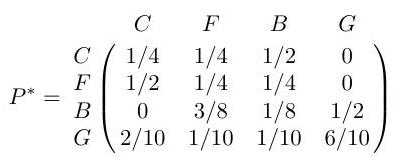A2.1
(i) Let be a proper subset of the finite state space of an irreducible Markov chain , whose transition matrix is partitioned as
If only visits to states in are recorded, we see a -valued Markov chain ; show that its transition matrix is
(ii) Local MP Phil Anderer spends his time in London in the Commons , in his flat , in the bar or with his girlfriend . Each hour, he moves from one to another according to the transition matrix , though his wife (who knows nothing of his girlfriend) believes that his movements are governed by transition matrix :

The public only sees Phil when he is in ; calculate the transition matrix which they believe controls his movements.
Each time the public Phil moves to a new location, he phones his wife; write down the transition matrix which governs the sequence of locations from which the public Phil phones, and calculate its invariant distribution.
Phil's wife notes down the location of each of his calls, and is getting suspicious - he is not at his flat often enough. Confronted, Phil swears his fidelity and resolves to dump his troublesome transition matrix, choosing instead

Will this deal with his wife's suspicions? Explain your answer.